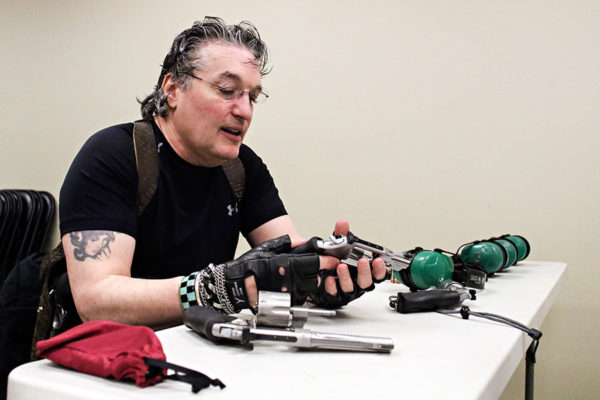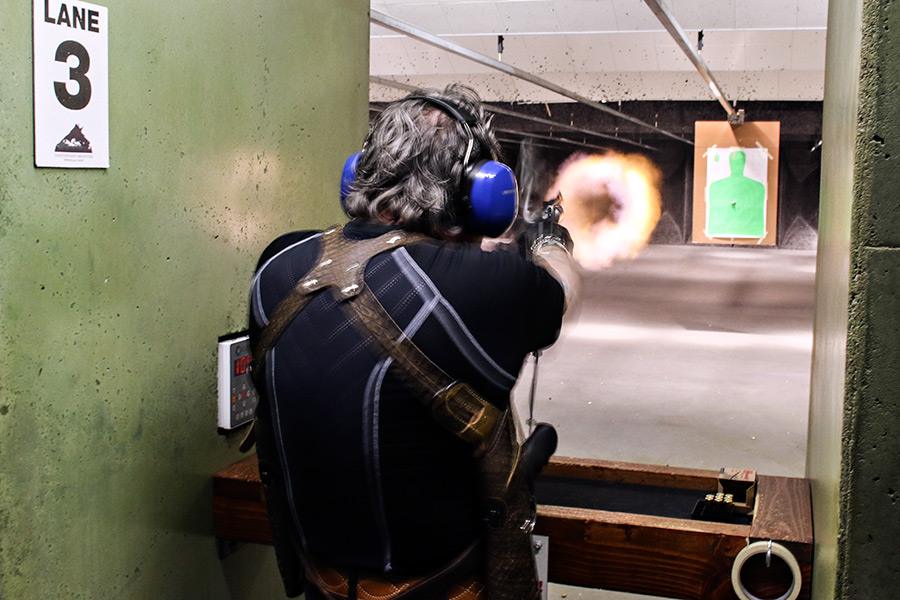COLUMBIA FALLS – Despite steeling oneself for the inevitable, it’s nearly impossible not to flinch when Lars Wood fires his short-barreled .44 Magnum revolver.
Even Wood, 62, who shoots this firearm regularly, takes precautions against constant exposure to the power. His right wrist is a tangle of metal bracelets, including a 1995 wedding present from his mother-in-law, the pressure from which help keep his arm and wrist muscles and tendons in line.
He’s a bit nervous because he’s got an audience watching him today. It’s usually just him, his manager Mark Cahill, and the friendly staff at Northwest Shooter, where Wood trains as he takes aim at setting the Guinness World Record for speed shooting large-caliber Magnum short-barreled revolvers this summer.
Since he’s a bit uncomfortable, Wood’s shooting spread is about palm-width. When he’s in his element, with his Bluetooth ear protection enabling him to listen to his tunes while he practices, Wood tends to shoot a whole cylinder of these massive bullets in a thumb-sized spread, according to Northwest Shooter staff.
“You need to be in shape for this,” Wood said before opening up on the range.
Wood’s training last week was about accuracy; on the weeks he goes for speed, he tends to tear up his trigger finger and destroy the rubber grips on his pistols. When he uses his custom wood grips — Wood holds a Federal Firearm License for gunsmithing — he’s more accurate, because they absorb more of the shock than the rubber grips.

All of these little details add up in a big way when it comes to being able to shoot for a world record. Jerry Miculek has been called “the greatest shooter of all time,” and he managed to empty a five-shot Smith & Wesson Model 64 ported barrel revolver in 0.57 seconds, grouping his shots into the size of a playing card.
It’s a world wherein records depend on tenths of a second, and where having legitimate claims to speed and accuracy depend on witnesses and recordings. Wood, a regular in the Flathead Valley’s shooting scene for years, recently met up with his manager, Cahill, when Wood’s truck broke down.
Cahill said he stopped to give Wood a ride, and they got to chatting about shooting. It was Cahill’s suggestion to start recording Wood’s shooting feats, and then Cahill became Wood’s manager.
“I wouldn’t be doing this if it wasn’t for Mark,” Wood said.
Cahill said he was surprised to hear about Wood’s background, which includes shooting in the Olympic Trials and a history as a research scientist.
Wood, who acknowledges his Boston accent with stories of using lines from the movie “Good Will Hunting” with his brother when they go out together, didn’t start shooting pistols seriously until he had his job as a research scientist in the late 1980s.
He was looking for a stress-relieving activity and decided to head to the gun range. A natural, Wood started shooting in revolver competitions, qualifying for the Olympic Trials in Los Angeles in 1987.
“I didn’t make the team, but I learned a lot,” Wood said. “I realized I wanted the unification of Olympic shooting and combat shooting.”
Marrying the two types of shooting would allow for super-fast shots with precision. Wood regularly makes modifications to his revolvers, timing them perfectly to shoot as fast as the mechanism will allow without locking up. All of his work is done by hand.
When he’s shooting, Wood uses a whole system to hit the target, one he says starts with his mind and knowing the timing of his firearm, and letting his body and brain work in tandem without getting in the way.
Each pull of the trigger detonates a small shock wave, blowing behind Wood at the range at the same time the target in front of him keeps disintegrating. In the silence of the last blast, Wood lowers his arms, calls back the target, and checks his spread.
Then he reloads.
